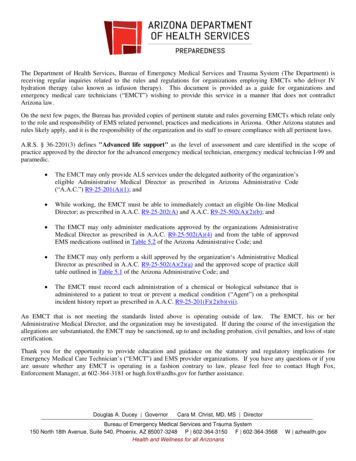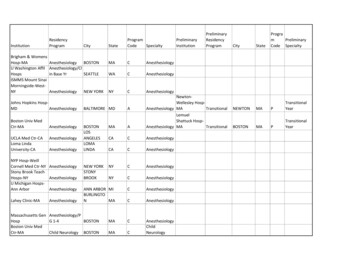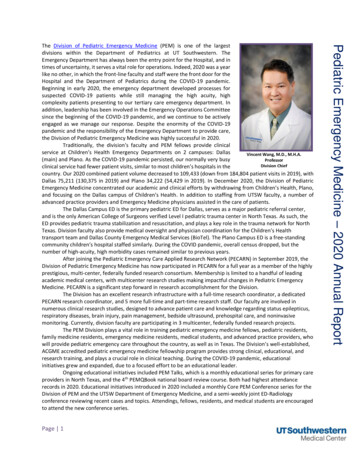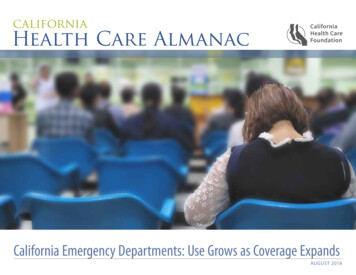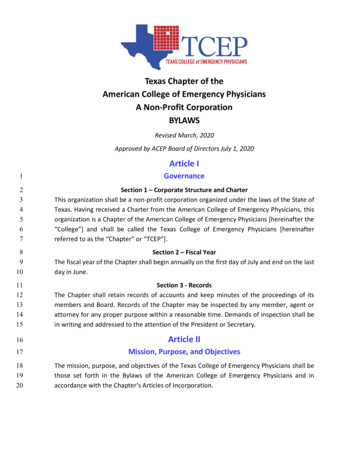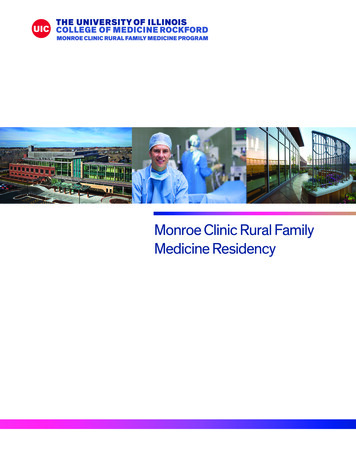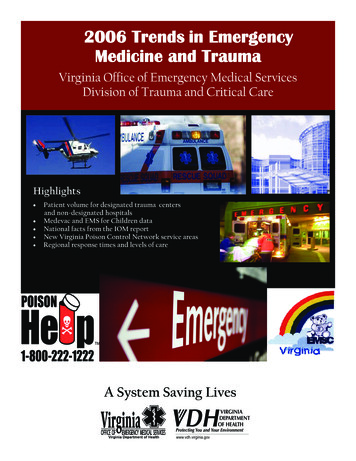
Transcription
2006 Trends in EmergencyMedicine and TraumaVirginia Office of Emergency Medical ServicesDivision of Trauma and Critical CareHighlights Patient volume for designated trauma centersand non-designated hospitalsMedevac and EMS for Children dataNational facts from the IOM reportNew Virginia Poison Control Network service areasRegional response times and levels of careA System Saving Lives
The following are excerpts from the Code of Virginia as well as the Virginia Statewide Trauma RegistryReporting Requirements. These documents provide an insight into the data that were used in creating thisreport.§ 32.1-116.1. Prehospital patient care reporting procedure; trauma registry; confidentiality.A. In order to collect data on the incidence, severity and cause of trauma, integrate the information available from other stateagencies on trauma and improve the delivery of prehospital and hospital emergency medical services, there is hereby established the Emergency Medical Services Patient Care Information System. The Emergency Medical Services Patient Care Information System shall include the prehospital patient care reporting procedure and the trauma registry.All licensed emergency medical services agencies shall participate in the prehospital patient care reporting procedure bymaking available to the Commissioner or his designees the minimum data set on forms prescribed by the Board or locally developed forms which contain equivalent information. The minimum data set shall include, but not be limited to, type ofmedical emergency or nature of the call, the response time, the treatment provided and other items as prescribed by theBoard.Each licensed emergency medical services agency shall upon request disclose the prehospital care report to law-enforcementofficials (i) when the patient is the victim of a crime or (ii) when the patient is in the custody of the law-enforcement officialsand has received emergency medical services or has refused emergency medical services.The Commissioner may delegate the responsibility for collection of this data to the Regional Emergency Medical ServicesCouncils, Department of Health personnel or individuals under contract to the Department. The Advisory Board shall assistin the design, implementation, subsequent revisions and analyses of the data of the prehospital patient care reporting procedures.B. All licensed hospitals which render emergency medical services shall participate in the trauma registry by making available to the Commissioner or his designees abstracts of the records of all patients admitted to the institutions' trauma andgeneral surgery services with diagnoses related to trauma. The abstracts shall be submitted on forms provided by the Department and shall include the minimum data set prescribed by the Board.The Commissioner shall seek the advice and assistance of the Advisory Board and the Committee on Trauma of the VirginiaChapter of the American College of Surgeons in the design, implementation, subsequent revisions and analyses of the traumaregistry.(1987, c. 480; 2002, cc. 568, 658; 2003, c. ——————Cases required to be reported to the Virginia Statewide Trauma Registry:1. Injured/Trauma patients admitted to the facility with ICD9-CM codes of 348.1, 800.0 - 959.9, 994.0 and 994.1, excluding 905-909 (late effect injuries), 910-924 (blisters, contusions, abrasions and insect bites), and 930-939 (foreign bodies).This reporting includes ALL admissions, including 23 hours admits for observation, as an inpatient; NOT emergency room observation unless held in the emergency room due to no inpatient bed availability. Patients not admitted to an inpatient status do not need to be reported. Italso includes reporting all admissions for patients where the trauma codes are secondary diagnoses.2. Injured/Trauma patients transferred from one hospital to another because of acute trauma, patient may be transferreddirectly from the emergency department or from an inpatient unit.3.Victims of acute trauma that die within the hospital, including, the emergency department and those who are DOAafter arrival to the �———————Office of Emergency Medical Services Mission StatementTo reduce death and disability resulting from sudden or serious injury and illness in the Commonwealth through planningand development of a comprehensive, coordinated statewide EMS system; and provision of other technical assistance andsupport to enable the EMS community to provide the highest quality emergency medical care possible to those in need.2
2006 Trauma in Virginia-Designated Trauma CentersAll licensed hospitals are required by the Code of Virginia to submit data on their trauma cases to the VirginiaStatewide Trauma Registry. Of those 94 licensed hospitals, 13 have been recognized as designated trauma centers. A trauma center’s designation is defined by the following criteria:Level ILevel I trauma centers have an organized trauma response and are required to provide total care for every aspect of injury,from prevention through rehabilitation. These facilities must have adequate depth of resources and personnel with the capability of providing leadership, education, research and system planning.Level IILevel II trauma centers have an organized trauma response and are also expected to provide initial definitive care, regardlessof the severity of injury. The specialty requirements may be fulfilled by on call staff, that are promptly available to the patient. Due to limited resources, Level II centers may have to transfer more complex injuries to a Level I center. Level II centers should also take on responsibility for education and system leadership within their region.Level IIILevel III trauma centers, through an organized trauma response, can provide prompt assessment, resuscitation, stabilization,emergency operations and also arrange for the transfer of the patient to a facility that can provide definitive trauma care.Level III centers should also take on responsibility for education and system leadership within their region.Level I Trauma CentersLevel II Trauma Centers Carillion RoanokeMemorial Hospital Lynchburg General Hospital Inova Fairfax Hospital Riverside Regional Medical Center Sentara Norfolk General Hospital Winchester Medical Center UVA Health System VCU Health SystemsLevel III Trauma Centers Carilion New River ValleyMedical Center CJW Medical Center,Chippenham Campus Montgomery Regional Hospital Sentara Virginia Beach GeneralHospital Southside Regional Medical Center3
2006 Trauma in Virginia-TriageInjury Severity Scores (ISS)Virginia’s State Trauma Triage PlanDESIGNATED TRAUMACENTERUnder the Code of Virginia § 32.1-111.3, the Office ofEmergency Medical Services (OEMS) acting onbehalf of the Virginia Department of Health hasbeen charged with the responsibility of developing a statewide trauma triage plan. This plan isto include pre-hospital and inter-hospital patienttransfers.NUMBER OFCASES*—Level I—The Code directs the collection of data throughthe EMS and state trauma registry and protectsits ability to be used by trauma committees thatreport to the State EMS Advisory Board.Carillion RoanokeMemorial10791Inova Fairfax112866Sentara Norfolk General111297UVA111435VCU113707Lynchburg General81373Riverside Regional9887Winchester Medical91219Carillion New River Valley****CJW-Chippenham****Montgomery Regional****Virginia Beach General9859Southside Regional****—Level II—Recognizing the complexity of Virginia’s variability in demographics and geography, the statetrauma triage plan has been designed to set atemplate for the Regional EMS Councils to develop, monitor and revise a regional trauma triage plan. Through regional Trauma PerformanceImprovement Committees, issues in trauma carecan be addressed.—Level III—Virginia’s Trauma Triage Plan can be found enters.asp*Represents the number of cases with a valid ISS reported**Not currently reporting ISSLiterature Brief:Location of Admission80%Designated Trauma CenterNon-designated Hospital60%Trauma Team Activation: SimplifiedCriteria Safely Reduces Over-triageAmerican Journal of Surgery, May 2007A retrospective review at a Level II trauma center wasconducted to identify the most reliable variables fortrauma triage. Logistic regression demonstrated thatthe following factors independently predicted the needfor urgent intervention:1. Prehospital Glasgow Coma Score 142. Hypotension3. Altered respiratory effort4. Penetrating truncal OEDRoomperatingotAOWhen these four injuries were used as indicators, itsignificantly decreased over-triage and reliably identified patients with severe injury.*Full citations of all articles can be found on page 27 of the appendix.NIntensiveCareUnit0%FloorAVERAGEISS4
2006 Trauma in Virginia-TriageLiterature Brief:Interfacility TransportsInterfacility transports can be used as an indicatorof over/under triage. Below are severaltriage scenarios using 2006 VSTR data.The Identification of Criteria to EvaluatePrehospital Trauma Care Using the DelphiTechniqueThe Journal of Trauma, March 2007Trauma system performance improvement emphasizes outcome measures such as mortality and morbidity, with littlefocus upon the processes of pre-hospital trauma care. Thisstudy identifies the most important filters for auditing prehospital trauma care using the Delphi technique. This technique is used in research to achieve a consensus of expertopinion.Eighty-one experts in trauma care from the United Stateswere asked to generate filters that could be used in monitoring the pre-hospital aspect of the trauma system. They werethen required to rank these questions/filters in order of importance.Twenty-eight filters ranking in the highest tertile are proposed. The majority (54%) pertain to aspects of emergencymedical services, which comprise seven of the top ten (70%)filters. Triage filters follow in priority ranking and filters concerning interfacility transfers and transportation ranked lowest.TransferredFromTransferred ToTotalDesignated TraumaCenter, Level I or IIDesignated TraumaCenter, Level II or III0Designated TraumaCenter, Level II orIIIDesignated TraumaCenter, Level I or II277Designated TraumaCenter, Any alDesignated TraumaCenter, Any Level1470Initial Transport Method UtilizedThe top ten filters of highest priority are as follows:DesignatedTraumaCenters1.2.A patent airway should be maintained in all patients.EMS must document the indication for cricothyroidotomy.3. Hemorrhage control should be performed in all patients.4. EMS must document the indication for rapid sequenceintubation.5. EMS proficiency in technical performance should bemonitored annually.6. EMS personnel should receive annual performance feedback.7. Logistics of transportation should be a factor for dispatching air transportation.8. Instances and causes of trauma center diversion shouldbe monitored.9. The indication for pre-hospital intubation should bemonitored.10. Cases of undertriage should be monitored to identify acause.*Full citations of all articles can be found on page 27 of the 46,60717,141Not listed1,0353,9274,962Private Vehicle1,5332,6164,149Helicopter1,40571,412Walk In6095491,158N/A8070807Other147277424Police Vehicle174360Public Transportation21012
2006 Trauma in Virginia-DemographicsNational Fact:Emergency departments (ED’s) today provide much of the medical care for patients without medical insurance. Insuredpatients also increasingly turn to the ED during times when their physician is unavailable, such as evenings and weekends, and they are often sent to the ED for tests and procedures that their physician can’t easily perform in the office. Insome rural communities, the hospital ED may be the main source of health care for a large percentage of residents.2006 Institute of Medicine Report “Hospital-based Emergency Care at the Breaking Point”Age and Race DistributionAge and Race DistributionDesignated Trauma CenterNon-designated Hospital1,500Unknow nUnknow nOtherOtherBlack2,00000 an 465-74785 5-8an 4dupWhiteWhiteAge and Gender Distribution2,500Designated Trauma Center - FemaleDesignated Trauma Center - MaleNon-designated Hospital - FemaleNon-designated Hospital - 910-1459140 1 1Black35-441,0003,0006
2006 Trauma in Virginia-Admissions-SummaryIn 2006 there were 16,089 trauma admissions to designated trauma centers and 14,113 to nondesignated hospitals. The number of admissions to non-designated hospitals rose 16% from last yearwhile the number for trauma centers remained virtually the same.Hourly Trauma Distribution1,200Designated Trauma CenterNon-designated Hospital8004000a.m. :00 a.m. :00 a.m. :00 a.m. :00 a.m. :00 a.m. :00 p.m. :00 p.m. :00 p.m. :00 p.m. :00 p.m. :00 p.m.86846422101012:0012Daily Trauma Distribution3,000Designated Trauma CenterNon-designated ayThursdayFridaySaturdayMonthly Trauma DistributionDesignated Trauma CenterNon-designated stJulyJuneMayApri lhMarcFebruaryJanuary0
2006 Trauma in Virginia-Mechanism of Injury-SummaryExternal injury codes (e-codes) permit classification of environmental events, circumstances, and conditions as the causeof injury, poisoning, and other adverse effects. For the trauma registry, e-codes relating to the mechanism of injury, aswell as the location of the injury, are collected.The table below shows the ten most commonly reported individual e-codes and the corresponding average and medianlength of stay. The graph on the bottom of the page shows the most common e-code groupings and the correspondingtotal length of stay and intensive care unit (ICU) length of stay, if applicable. In 2006 there were 467 unique e-codes reported, the ten most common (listed below) comprise 55% of all cases.Length of Stay (LOS) for the Ten Most Common Injury Mechanismse-codeMechanism y885.9Fall on same level, slip/trip/stumble: Other544,822888.9Unspecified fall544,097816.0Motor vehicle traffic accident due to loss of control, without collision onthe highway: Driver of motor vehicle other than motorcycle521,703812.0Other motor vehicle traffic accident involving collision with motor vehicle: Driver of motor vehicle other than motorcycle521,397880.9Fall on/from stairs/steps431,215884.9Fall from one level to another42964888.8Other unspecified fall64617816.1Motor vehicle traffic accident due to loss of control, without collision onthe highway: Passenger in motor vehicle other than motorcycle62593812.1Other motor vehicle traffic accident involving collision with motor vehicle: Passenger in motor vehicle other than motorcycle42582881.0Fall from ladder42566Average Total and ICU Length of Stayby Injury Mechanism6Total LOSICU LOSDays420Cut/PierceFallFirearmMachinery8Motor Vehicle Pedal CyclistCrashStruck by,againstOtherTransport.
2006 Trauma in Virginia-Mechanism/DiagnosisTop TenInjury LocationsHomeStreet/HighwayUnspecifiedResidential institutionOther specified place ofoccurrencePlace for recreation andsportIndustrial premisesPublic buildingFarmMine/QuarryTen Most Common Diagnosis Groups1,200Designated Trauma CenterNon-designated Hospital8004000kkeblv isnnceunturimbperrunli mti oraiurn/tctt/f/aBasf lnl l/fakko/creofuccnollieelmeskndraDisdoturd/nenofous kuSpea/abra cre/of ththnwuFoswtedecyreunOpchj urFractuwol inuryjnaiFraneialranOpernracIntIntMechanism of Injury by Age4,500FallMotor Vehicle CrashCut/PierceStruck by, against3,000Firearm1,5000 8485 andupNational Fact:The number of patients visiting emergency departments has been growing rapidly. There were 113.9 million ED visits in2003, up from 90.3 million a decade earlier. During the same time, the number of facilities available to deal with thesevisits has been declining. Between 1993 and 2003, the total number of hospitals in the United States decreased by 703,the number of hospital beds dropped by 198,000, and the number of emergency departments fell by 425.2006 Institute of Medicine Report “Hospital-based Emergency Care at the Breaking Point”9
2006 Trauma in Virginia-Outcomes-Summary-The overwhelming majority of trauma patients, in both designated trauma centers and non-designated hospitals, aredischarged to their home. A smaller number of patients receive some type of further treatment such as being dischargedto an inpatient rehabilitation or a skilled nursing facility. Those cases are primarily older patients that have sufferedfrom pelvic/hip fractures. Transfers to another acute care facility occur when patients need a definitive level of traumacare that cannot be obtained at a Level III or non-designated hospital. The total number of deaths attributed to a traumatic injury in 2006 was just under 1,000.Figures do not represent unique patients. A single patient may have more than one diagnosis code, for example, a patient that was ‘discharged home’ that had numerous fractures may be listed under ‘fracture of limb’ as well as ‘fracture ofneck/trunk’, for example.Discharged Home12,0008,0004,0000kbrekvise/tru nf l imb/tru nn/pelof li mrac tul l/fa cne ckure o/ne ckom eundkul l ff s kutfddoscooabwaoerea/er/Fwtustturof hO penFra cf c heinj uryF ra cundj ury on woan ialreincplaarOnIntInterFurther Treatment6,000Inpatient Rehabilitation4,000Skilled Nursing FacilityTransfer to another Acute Care Facility2,0000kbrekvise/tru nf l imb/tru nn/pelrac tuof li ml l/fa c/ne ckom eure one ckkul l ff s kutfddoundscooabwaoerea/e/rnFsttuturof hry wO peF ra cf c heFra cundl inj un woj ury oran iaeincplaarOtnInInterAdditional Outcomes250Left Against Medical AdvicePrison / Jail125Residential Facility0bbnkl visurenkceof li mof l imfrac tck /truen/peul l/fack /truounds kul lctureof s kof nead/nebdomwaoerea/e/rnhtrFwuefstutoOpj uryc heFra cFra coundial inry ofc ranpen wl inj uaOnrIntr aInte10
2006 Trauma in Virginia-Trauma Fund-SummarySince 2004 the Virginia Trauma Center Fund distributes funds to Virginia DesignatedTrauma Centers to offset the costs associated with being designated. The funds are collected from several sources including DMV license reinstatement fees and DUI fines.OEMS is the designee that is charged with developing a distribution model for thesefunds and providing payment to Virginia designated trauma centers. 100% of the fundscollected are passed on to the qualifying hospitals on a quarterly basis.PercentDistributionPreviousDistributionsJuly 2007Payment7.21%23.54%11.83%12.99%29.11% 1,890,998.21 3,603,046.01 1,981,808.85 1,766,881.30 2,321,013.33 414,011.43 788,843.81 433,893.34 386,820.00 508,158.10 2,305,009.64 4,391,889.82 2,415,702.19 2,153,701.30 2,829,171.43IILynchburg General HospitalRiverside Regional Medical Ctr.Winchester Medical Ctr.2.81%3.45%4.19% 149,570.47 185,627.65 356,565.34 32,746.67 40,640.95 78,065.71 182,317.14 226,268.60 434,631.05IIINew River Valley Medical Ctr.CJW Medical Ctr.Montgomery Regional HospitalSouthside Regional Medical Ctr.Virginia Beach Gen'l Hospital0.22%0.24%0.17%0.39%3.84% 33,386.28 241,716.58 86,804.30 99,590.98 651,699.94 7,309.52 52,920.95 19,004.76 18,712.38 142,681.91 40,695.80 294,637.53 105,809.06 118,303.36 794,381.85Trauma Center LevelIRoanoke Memorial HospitalInova Fairfax HospitalNorfolk General HospitalUVA Health SystemVCU Health SystemsTotal100.00%Total FundsReceived 2,923,809.53 16,292,518.77To offset the cost of programs required by Virginia trauma center designation TraumaCenter Fund monies are to be used to support the following general activities: An administrative infrastructure dedicated tothe trauma program as required for designation, such as a trauma medical director,trauma nurse coordinator, etc.Higher staffing levels required to providequality trauma care.Trauma specific training such as physiciancontinuing medical education (CME), nursing education, educational materials etc. Injury prevention/community outreach projects.Outreach efforts such as those envisionedthrough the State Trauma Triage Plan i.e. communicating with EMS agencies and nondesignated hospitals.Trauma specific research to assist in improvingtrauma care system wide.11
2006 Trauma in Virginia-Cardiac Arrest-Summary-Level of Care by Region100%75%50%BLS25%ALSCentra Bl ulS eRhe idn geL anN ord doaorth Fai herrn faxO Vi rgldD ini aomPe i nRn io nSo app ins uu t ah lahw a sTh es nnoom t V c kas irgJe in iaffeW Tid rs oes e nte warnteVi rrginia0%In 2006 there were 7,392 reports of“cardiac arrest”, down slightly from2005. 221 cases were under the age of 19.Graphs on this page represent data fromthe 7,392 cardiac arrest cases. Of callsdeemed to be a cardiac arrest, 62% weretreated and transported; 25% were reported to be dead at the scene.EKG Results50%EKG InitialEKG ctri e0%Age by Region25%Blue RidgeCentral ShenandoahLord FairfaxNorthern VirginiaOld DominionPeninsulas20%15%RappahannockSouthw est VirginiaThomas JeffersonTidew ater10%Western Virginia5%0%12No AgeListed 8485 andup
2006 Pre-hospital Care-Call Volume-SummaryEvery emergency medical service (EMS) agency operating in Virginia must comply with thespecifications of section 32.1-116.1 of the Code of Virginia. This section requires all licensedEMS agencies to participate in the pre-hospital patient care reporting procedure by making available the minimum data set which is currently comprised of 62 data elements.The Pre-hospital Patient Care Report (PPCR) form is completed by EMS providers onevery call to document the response, care and/or services provided to every patient. ThePPCR system is the pre-hospital electronic medical records database of EMS informationand is designed to be a critical link to the future of EMS in Virginia. The PPCR system provides a method for every licensed EMS agency in Virginia to enter patient care data into acentral database.The Pre-hospital Patient Data Record (PPDR) is based on every PPCR form completed forevery patient. PPDR software is available, at no cost, through OEMS.Call Distribution byDay of the WeekCall Volume by Q32006Q42006Hourly Call Distribution40,0004,000All CallsMVC Calls*30,000Cardiac Calls**Use scale on right3,00020,0002,00010,0001,000012-12:51- 9 a1: m52- 9 am2:53- 9 a3: m54- 9 a4: m55- 9 a5: m56- 9 am6:57- 9 a7: m58- 9 a8: m59- 9 a9: m10 59-1 a0 m11 :59-11 am12 :59-12: am51- 9 p1: m52- 9 pm2:53- 9 p3: m54- 9 p4: m55- 9 p5: m56- 9 pm6:57- 9 p7: m58- 9 p8: m59- 9 p9: m10 59-1 p0 m11 :59-11: pm59pm013
2006 Pre-hospital Care-ReportingThe Future of Virginia’s Pre-hospital Patient Care Reporting SystemWeb based PPCR/PPDR— The new, proposed, EMS Registry will be a Web based data collection toolthat utilizes electronic medical record technology and will eliminate the current paper based system. Byconverting to a Web based electronic patient care report (e-PCR), data submission will no longer be a separate function for the over 700 hundred EMS agencies. Instead, data submission will occur as a normal part ofmedical record charting through an e-PCR.By converting the current outdated technology with the proposed program, data will become near real time(within 24-48 hours), and therefore a degree of health care surveillance will be added to the system. In addition, EMS treatment can be assessed, and new innovations in emergency care, as well as systems issues canbegin sooner. Poor compliance will also be resolved by having an electronic data collection system, as transcribing patient encounters manually will no longer be required.Most important is the fact that with the initiation of this project, OEMS will put into place the nationaldataset as agreed to in a 2003 memorandum of understanding with the National EMS Information System(NEMSIS). This monumental effort is to assure that each data element collected by the localities, the regions, the state and the national database are exactly the same, for more reliable analysis.NEMSIS will create a standardized method in which every state collects pre-hospital data. Such standardization will allow agencies throughout the country to make comparisons on an agency, city/county, and statelevel. This will facilitate quality improvement programs, encourage research efforts, help prioritize limitedfunds for appropriate equipment and education, and enable benchmarking at local, state, and nationallevels.More information about NEMSIS is available at www.nemsis.org.Incident DispositionDead at scene1%Unknow n0%Treated, transportedby private vehicle0%Treated and released1%No treatment required3%No patient found3%Cancelled4%Not portedby EMS66%Patient refused care10%14Type of CallMedical Emergency418,396Injury not listed/Other67,596Accident/Motor lt8,619Mutual Aid/Standby5,721Public ion4,248
2006 Pre-hospital Care-Response Times-SummaryAs PPCR reporting compliance increases, statewide andregional response times can be calculated. There are manyreasons why reporting frequency differs for each portionof the call. Reasons may include: a call beingcancelled before personnel arrive at the scene, no patientbeing found at the scene or no transport necessary onceproviders have evaluated the patient. Due to these inconsistencies, the calls were broken down and separate averages were calculated for each stage of the response. A95% trimmed mean was used to eliminate the highest andlowest 2.5% of responses. This method provides an unbiased, objective way to eliminate nonsense entries acrossthe board.The total number of calls used to calculate the regionalresponse times as well as definitions of each stage of theresponse can be found on page 26 of the appendix.Statewide Response TimesAverage*(minutes)Numberof CallsUnit Dispatched/Unit Enroute2646,084Unit Enroute/Arrive Scene6617,804Arrive Scene/ArrivePatient5525,529Arrive Patient/Leave Scene17482,794Leave Scene/Arrive Destination15468,840Arrive Destination/Return to Service29449,722Response Time by Region40Average* Response Time (minutes)35302520Blue RidgeCentral ShenandoahLord FairfaxNorthern VAOld DominionPeninsulasRappahanockSouthwestThomas JeffersonTidewaterWestern151050Unit Dispatched/UnitEnrouteUnit Enroute/Arrive Arrive Scene/Arrive Arrive Patient/Leave Leave ination/Return toService*95% trimmed mean15
2006 Pre-hospital Care-Level of Care-Summary-Level of Care by RegionLevel of Care: Statewide, 78% of all EMS calls providedbasic life support (BLS) care. The level of care providedvaries by region. Across the state, Central Shenandoah hadthe highest percentage of BLS calls while Western, Southwest and Thomas Jefferson had the highest percentage ofALS calls, each at 27% of their call volume.Attendant in Charge: In over one-third of cases (36%),statewide, the attendant in charge (AIC) was an emergency medical technician (EMT) basic. The AIC distribution for the remaining cases are as follows:32% EMT Paramedic16% EMT Intermediate7% EMT Cardiac Technician5% EMT Shock Trauma2% Other Healthcare Professional1% Nurse 1% OtherNumber ofCallsSouthwest50,90327Thomas Jefferson21,18227Western Virginia77,36427Lord r111,59519Blue Ridge26,18118Rappahannock41,13817Northern Virginia79,14315Central Shenandoah38,60011Old DominionLocation: Pre-hospital care is given in the home almostfour times more than any other location. In 2005, 23% ofcalls to the home required ALS care. This figure has remained constant in 2006.Level of Care by Location100,000* “Home/Residence” BLS carevalue 272,652BLSALS50,0000nce *ati onation nk nown pre mis es or s port nsti tutio n e/Qua rr ytutio nwayi ldi ngesi de t o r hi gh ub lic Bu nti al Insti c ifi ed l oc ci fied locUR/nal I arm/MinandationPeeepelac e for rec re Edu cati oStreeFpHomUns plRes id O ther siatrPl aceIndus16PercentALS
2006 Pre-hospital Care-DemographicsAge and Gender 004758 5 -8 4andup465-7455-6445-5435-4425-3920-2415-110-15914 10Approximately 20% of cases did not report a patient gender.White, Non-hispanic50.3Black, Non-hispanic21.6Missing13.0Unknown9.0White, Hispanic1.9Not Applicable1.5Other1.4Asian / Pacific Islander0.6Black, Hispanic0.5American Indian / AlaskaNative0.1Ten Most Common Clinical Assessments by Age25,000OtherTraumatic InjuryUnknownRespiratory DistressChest Pain / DiscomfortGeneral IllnessAbdominal Pain / ProblemsAltered Level of 455-6445-5435-4425-3420-2415-1910-145914 1017
2006 Pre-hospital Care-Mechanism of Injury-SummaryFalls and motor vehicle collisions comprise 65% of all cases with known injury mechanisms.Falls are most prevalent in the elderly population, peaking in the 74-85 year age range. Motor vehicle collisions occur in a bell shaped, or normal distribution, peaking in the 25-34 age range.The majority of calls receive BLS care and cases where ALS care is provided follow the same age distributionas BLS cases but at a much smaller percentage.Top TenMechanisms of InjuryDistribution of Falls andMotor Vehicle Collisions (MVC) by Month6,000FallsMotor vehicle collision(public road)U
Prehospital Trauma Care Using the Delphi Technique The Journal of Trauma, March 2007 . were asked to generate filters that could be used in monitor-ing the pre-hospital aspect of the trauma system. They were . Private Vehicle 1,533 2,616 4,149 Helicopter 1,405 7 1,412 Walk In 609 549 1,158 N/A 807 0 807



